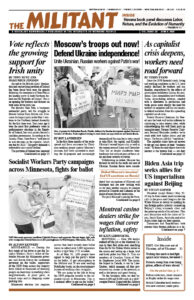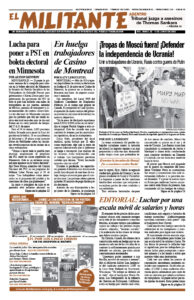Demonstrations against government moves to lift subsidies on basic foods, which touched off a torrent of rising prices, erupted across Iran in mid-May. They spread to dozens of cities and towns. Protesters in many of the actions raised political slogans, demanding “Down with [Supreme Leader Ayatollah Ali] Khamenei, down with dictator” and “We don’t want mullahs ruling.”
The actions reflect mounting opposition by working people to the bourgeois-clerical regime’s counterrevolutionary rule, including its military and political interference across the Gulf region, from Iraq and Syria to Lebanon and Yemen.
The actions responded to the Iranian government’s announcement May 11 cutting state subsidies on essential items, including cooking oil, eggs, milk and chicken. This resulted in price hikes by as much as 300% for a variety of flour-based staples like bread and 400% on pasta, a staple of the Iranian diet. Eggs and chicken nearly doubled. Cooking oil increased by over 400% overnight.
Prices rising ‘by the hour’
Prices were rising “by the hour,” Mohammad, a 40-year-old private sector worker, told Agence France-Presse in Tehran. “How can people live like this?”
Promises by the administration that prices would be reduced have not quieted protesters, who are fed up with years of anti-working-class government attacks.
The protests quickly spread to provinces of Isfahan, Khuzestan, Lorestan, Ardebil, Charmahal and Bakhtiari, Kohgiluyeh and Boyer-Ahmad. In an effort to stifle the demonstrations, Iranian officials cut off internet in areas with ongoing protests. Demonstrators have faced attacks by the notorious Basij militia, which has been used in the past to crack down on protests.
Iranian authorities have yet to report any deaths. However, Al Arabiya, Saudi Arabia’s semi-official TV network, reported May 18 at least six people have been killed since the protests began.
One of the largest actions was in Dezful, in the oil-rich southwestern province of Khuzestan, where the IRNA, Iran’s official news agency, reported cops dispersed hundreds of people and arrested 15.
“There were lots of anti-Khamenei slogans simply because he’s the one responsible for our situation,” said a Twitter message from a protester at the action. “His politics over the past 30 years have brought us here — useless uranium enrichment, interfering in internal affairs of neighboring countries, stupid enmity with Israel, the list is long.”
Iran’s workers and farmers are facing the impact of the worldwide capitalist economic crisis, compounded by the economic sanctions imposed by Washington and other imperialist powers that hit working people the hardest. The official inflation rate is about 40%. Almost half Iran’s of 82 million population live below the government’s official poverty line.
It’s getting harder and harder to get and hold down a job, with the value of wages eroding. According to Iranian government statistics, over 22% of Iran’s youth are unemployed. In some provinces, like Khuzestan, it’s up to 33%. And growing numbers of young people have to move in with their parents because they can’t afford to make it on their own.
Amid these spreading demonstrations, dozens of union bus drivers in Tehran walked off the job May 16 demanding payment of overdue wages and a substantial raise that had been approved by the Supreme Labor Council more than two months ago. The Syndicate of Workers of Tehran and Suburbs Bus Company reported that a dozen of its members were detained the next day. The unionists have vowed to keep up the fight until their demands are met.
The strike follows weeks of strikes and protests by teachers in cities across Iran earlier this year.
Iranian toilers overthrew the pro-Washington regime of the shah in 1979 in a popular revolutionary upsurge. Workers committees — “shoras” in Farsi — were set up in factories, oil refineries and more; women joined in the struggle demanding equal rights; and oppressed nationalities like Kurds and Arabs fought for greater freedom. Over years these struggles were put down by the reactionary clerical rulers, but deep sentiments remained.
The latest actions reflect this, as well as growing anger against the regime in recent years based among poorer working people in cities and rural areas. This includes Iran-wide mobilizations in December 2017 and 2018 that swept some 90 cities and towns; mass protests in 2019 over gas price hikes and the effects of the regime’s war moves abroad; as well as protests in 2021, initially in response to widespread water shortages.


![Protests across Iran erupted in mid-May over government lifting of subsidies on basic foods, effects of rulers’ war moves in the region. Angry demonstrators raised political demands: “Down with [Supreme Leader Aya-tollah Ali] Khamenei!” and “We don’t want mullahs ruling!”](https://themilitant.com/wp-content/uploads/2022/05/IranProtest_8622.jpg)